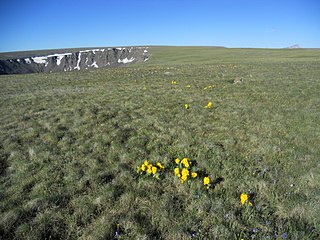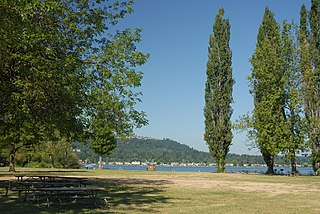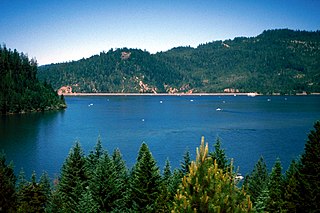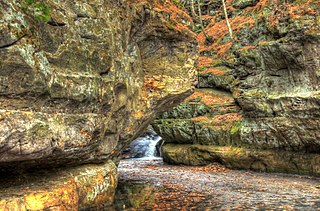
Camas is a city in Clark County, Washington, with a population of 26,065 at the 2020 census. The east side of town borders the city of Washougal, Washington, and the west side of town borders Vancouver, Washington. Camas lies along the Washington side of the Columbia River, across from Troutdale, Oregon, and is part of the Portland metropolitan area.

Washougal is a city in Clark County, Washington, United States. The population was 17,039 as of the 2020 census.

Lacamas Lake is a small lake in Clark County, Washington. It is a popular place to fish and water ski for locals from Vancouver, Camas and Washougal. It connects to Round Lake via a channel that runs under the SR 500 bridge on the southeast side of the lake. In the 1990s many high tech manufacturing plants and expensive housing developments began to appear in the area around the lake. The lake is very warm compared to other lakes in the area and the temperature can drop off quickly with depth. As it is now, the 60-foot-deep (18 m) lake cannot support life below about 18 ft (5.5 m). The Georgia-Pacific Mill in Camas used to draw water from the lake to support its operations; however, Georgia-Pacific donated the two dams on Round Lake to the City of Camas in 2018.
Camas Cemetery is a cemetery in Camas, Washington that was first used in 1860.

Lake Missoula was a prehistoric proglacial lake in western Montana that existed periodically at the end of the last ice age between 15,000 and 13,000 years ago. The lake measured about 7,770 square kilometres (3,000 sq mi) and contained about 2,100 cubic kilometres (500 cu mi) of water, half the volume of Lake Michigan.

The Portland metropolitan area is a metro area in the U.S. states of Oregon and Washington centered on the principal city of Portland, Oregon. The U.S. Office of Management and Budget (OMB) identifies it as the Portland–Vancouver–Hillsboro, OR–WA Metropolitan Statistical Area, a metropolitan statistical area used by the United States Census Bureau (USCB) and other entities. The OMB defines the area as comprising Clackamas, Columbia, Multnomah, Washington, and Yamhill Counties in Oregon, and Clark and Skamania Counties in Washington. The area's population is estimated at 2,753,168 in 2017.

The Washougal River is a 33-mile (53 km) tributary of the Columbia River in the U.S. state of Washington. Its headwaters and upper 21 miles (34 km) are in Skamania County in the Gifford Pinchot National Forest, and its lower 12 miles (19 km) are in Clark County. The river, which meets the Columbia near the cities of Washougal and Camas, is a popular stream for fishing, swimming, and boating.

The Powderhorn Wilderness is a 62,050-acre (251.1 km2) wilderness area in Hinsdale and Gunnison counties, Colorado, United States, located 5 miles (8.0 km) northeast of Lake City.

Banning State Park is a state park of Minnesota, USA, stretched along 10 miles (16 km) of the Kettle River near Sandstone in Pine County. The centerpiece of the park is 1.5 miles (2.4 km) of churning rapids, some up to Class IV. The daring kayakers and canoeists who shoot Blueberry Slide, Mother's Delight, Dragon's Tooth, Little Banning, and Hell's Gate each spring attract spectators to the park. Landbound visitors can hike along the state's first Wild and Scenic River amid dramatic sandstone rock formations, large potholes carved by the river, and the remains of an historic quarry. Other features are Wolf Creek Falls and Robinson Ice Cave. The park is located directly off Interstate 35. Banning State Park is open daily from 8am until 10pm. Each vehicle entering the park requires an up to date permit which can be purchased online or at the park office.

Tiger Mountain is a mountain in the U.S. state of Washington. It is at the center of the Issaquah Alps, a small range in the Eastside region of King County, Washington southeast of Seattle. The mountain is part of a designated protected area, the Tiger Mountain State Forest, and has several recreational areas used for hiking, mountain biking, and paragliding.

Whatcom Falls Park is a 241-acre (0.98 km2) park in Bellingham, Washington, United States. The falls are on Whatcom Creek, which leads from Lake Whatcom to Bellingham Bay. The park has four sets of waterfalls and several miles of well maintained walking trails.

Grove Field is a public airport located three miles (5 km) north of the central business district of Camas, a city in Clark County, Washington, United States. It is located near Lacamas Lake which has a seaplane base. Due to the closing of Evergreen Field, many aircraft have moved to Grove Field.

Lake Sammamish State Park is a park at the south end of Lake Sammamish, in King County, Washington, United States. The park, which is administered by the Washington State Park System, covers an area of 512 acres (0.80 sq mi) and has 6,858 feet (2,090 m) of waterfront; Issaquah Creek meets with Lake Sammamish within the park. It is a popular location for boating and watersport activities, such as waterskiing.

Fort Vancouver Regional Libraries is a public library system in southwestern Washington state. The library district was established in 1950 as the first inter-county rural library district in Washington. The district has grown since 1950 to serve all of Clark, Skamania and Klickitat Counties, and the city of Woodland and the independent Yale Valley Library District in Cowlitz County.

Lacamas Creek is in Clark County, Washington, United States, and flows about 12.5 miles (20.1 km) from headwaters near Camp Bonneville to Lacamas Lake and Round Lake in Camas, and eventually into the Washougal River. Its name is derived from that of the native camas plant. Lacamas Creek is fed by numerous streams, but the five largest tributaries are Matney Creek, Shanghai Creek, Fifth Plain Creek, China Ditch, and Dwyer Creek.

Lost Creek Lake is a reservoir located on the Rogue River in Jackson County, Oregon, United States. The lake is impounded by William L. Jess Dam which was constructed by the U.S. Army Corps of Engineers in 1977 for flood control and fisheries enhancement. The lake and dam were the first completed elements of the multi-purpose Rogue River Basin Project, consisting of Lost Creek Lake, Applegate Lake and the Elk Creek project. The lake is located approximately 27 miles (43 km) northeast of Medford.

Pewit's Nest State Natural Area is a nature reserve of Wisconsin, USA, that includes a deep gorge formed during the retreat of the last glacier. Pewit's Nest is outside Baraboo in Sauk County. At one time a waterwheel and mill were located on the site and an individual lived in the solid sandstone. The name of the site was a result of early settlers calling it "Peewit's Nest" after the abode, ten feet above a deep pool of water, resembling the nest of a phoebe. The water-wheel once turned lathes for repairing or manufacturing equipment, but no evidence of it remains. Pewit's Nest is owned by the Wisconsin Department of Natural Resources and was designated a State Natural Area in 1985.
Gee Creek is a 4th order tributary to the Columbia River, a.k.a. small creek, within Clark County, Washington named for William Gee, an early pioneer upon whose land the stream arose from. The Upper Gee Creek watershed, with an 8.7-square-mile (23 km2) drainage basin, is completely located within the Ridgefield quadrangle. The mainstem extends approximately 11.5 miles (18.5 km), of which 4.9 miles (7.9 km) are located within the Upper Gee Creek basin. Originating in the hills along Interstate 5, through Ridgefield, Washington and empties into a series of lakes on the Columbia River Floodplain. Abrams Park in Ridgefield is a local access point for Gee Creek and since 2003, has had a stream flow gauge installed to collect hydrological data. The lowest segment of Gee Creek meanders for 3 miles (4.8 km) through the Ridgefield National Wildlife Refuge.
The Port of Camas/Washougal is a port on the Columbia River serving the communities of Camas and Washougal, Washington in Clark County, Washington. The port was established in 1935 by a vote of the people in a special election and today encompasses the port, a marina, Grove Field airport and an industrial park. The port provides facilities and services for land, air, and water-borne use, and commerce to enhance employment and recreational opportunities for the communities of Camas and Washougal.
















